Climbing rose varieties
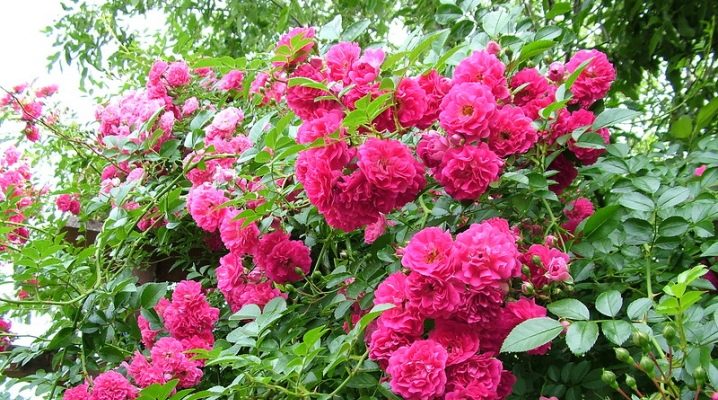
The rose is the best decorative element for any garden or yard. Each person will be able to choose the variety that they like, since the range of climbing roses is simply huge. Care and attention are important for these beautiful and fragrant flowers, and only then will the plant delight the owners for many years.
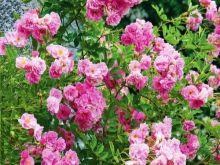
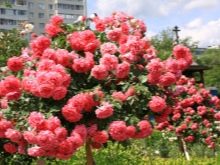
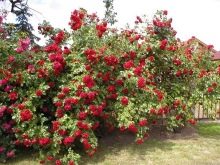
Varieties
For a beautiful design of your site, it is best to use climbing roses. Hardly anyone will remain indifferent to the delicate aroma, inspiring beauty and velvety texture of these plants. Such flowers will be a great addition to any landscape design, as well as they will become part of the original horizontal gardening.
Currently, there is a large varietal variety of climbing roses, so even the most demanding gardener can find a suitable option for himself.
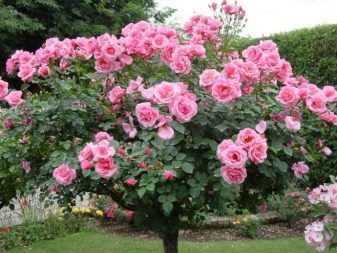
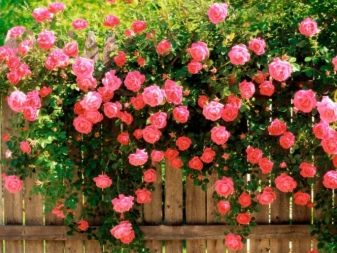
Climbing roses are divided into two types.
- Small-flowered. Such plants include varieties with a creeping or arched shoot, which can reach 5 meters in length. Plants of this type need support. During flowering, roses are covered with small double flowers, which reach a diameter of 2-3 centimeters. Plants bloom on last year's shoots, this process is characterized by abundance and duration. This group of roses has good winter hardiness.
- Large-flowered varieties characterized by the power of the stems, which reach a length of 200 centimeters. If the plant is tall and spreading, then it will need support. In the case of a strong erect stem, no support is required. Large-flowered varieties are characterized by flowers larger than 4 centimeters in diameter, which are collected in a brush.
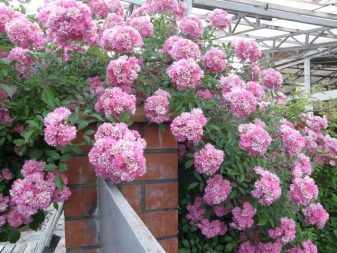
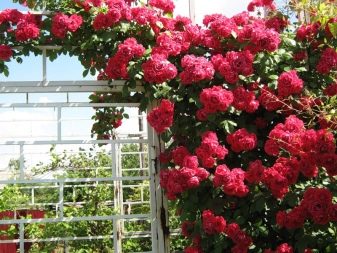
Consider the most popular varieties of climbing roses.
"Metanoya"
Variety "Metanoya" is presented in the form of powerful, wide bushes, which are covered with glossy leaves. The plant continues to bloom throughout the summer. The flower is characterized by moderate doubleness, medium size and a pleasant subtle aroma. The brushes consist of 7 flowers, each of which is about 9 centimeters in size.
The Metanoia shrub reaches a height of 2.2 meters and a width of up to 2 meters. The Krasnodar Territory, Astrakhan, and Crimea are considered favorable growing regions. This rose should be planted in the last days of April - early May. A feature of the variety is its resistance to precipitation. The flowers of the plant are similar to chrysanthemums, but their color is usually peach or orange.
The variety's description indicates that it is ideal for vertical gardening and container growing.
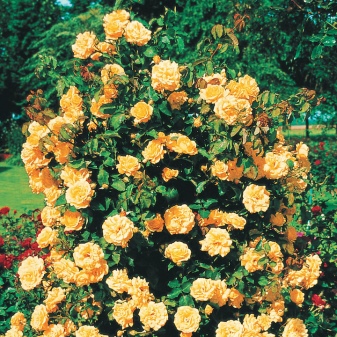

"Jardine"
This type belongs to climbing nostalgic roses. A feature of the plant is its resistance to sunlight. The flowers burn out to a more delicate pink color. The height of the shrub is from 3 to 4 meters, while its width is about 1.5 meters. They are able to decorate the garden with their beauty for a whole season. The variety is branched, it is resistant to diseases and pests.
This rose can be recognized not only by its large pink flowers that are collected in inflorescences, but also by its pleasant fruity aroma. The shape of the roses lasts quite a long time, without crumbling or fading. The plant prefers sunny locations, as well as fertilization and care.
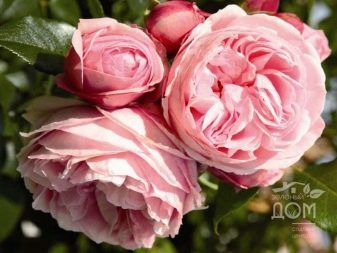
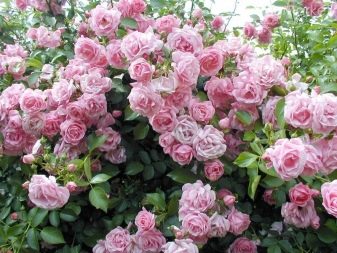
"Jasmine"
Rose "Jasmine" is considered a worthy rival of tea varieties. Each of the bushes of this plant is characterized by luxurious fragrant inflorescences. The main characteristics of the variety are the following:
- branched bushes up to 3 meters high and about 1 meter wide;
- developed root system, which is deepened into the ground;
- strong and straight stem;
- thin branches abundantly covered with thorns;
- foliage is medium in size, olive green and shiny surface;
- the flower is cupped, densely double, reaching 7 centimeters in diameter;
- the color of the petals is lilac-pink;
- the aroma has pronounced jasmine and lilac notes.
"Jasmine" is an unpretentious plant that can grow on the poorest soils. A freshly cut flower of the plant can last for about 14 days. The peculiarities of the variety include the need to bend its bushes for the winter period of the year, as well as damage to the rose during heavy rains.
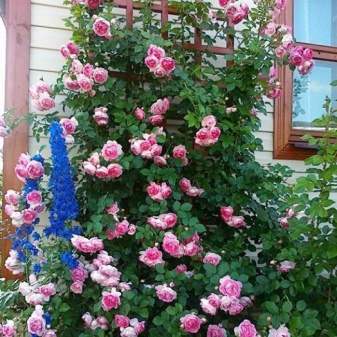
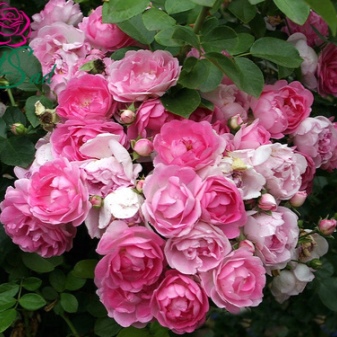
"Golden Perfume"
This variety is one of the most favorite among the country's gardeners. Thanks to the long pink lashes, it is possible to create charming arches and decorative compositions in the garden. The large-flowered representative of the flora is distinguished by double yellow flowers, which have a stable and pleasant aroma. The shrub of this variety is characterized by vigorous growth, large thickness of shoots and shine of green leaves.
The flowers of the plant reach 10 centimeters, while the bush itself is 2 meters high and 1.5 meters wide. The best growing regions for Golden Perfume are Moscow, Moscow Region, St. Petersburg, and the Far East. May or the first half of October is considered a favorable period for planting this variety.
The features of this variety of climbing rose include excellent wintering, the ability to grow in the shade, the continuity of flowering from June to September, as well as the minimum demand for care.

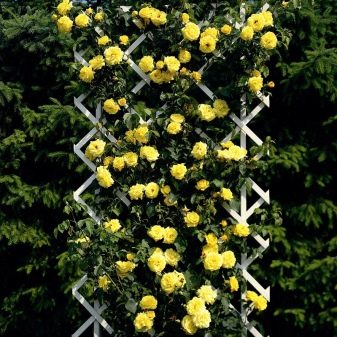
"Naema"
The scent of this flower contains a large percentage of pink essence. The flower smells like rose, peach, pear and lemon balm. The bush has large dimensions, while reaching a height of 2-3 meters and a width of 1.5 meters. The rose flowers of this variety are characterized by large size, dense doubleness, pleasant and beautiful pink color. The flowering period of this plant is from June to October.
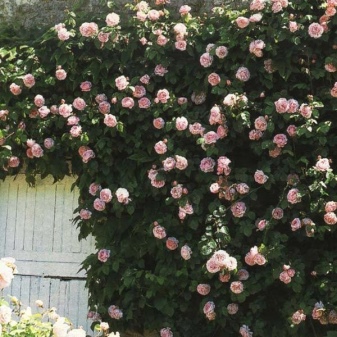
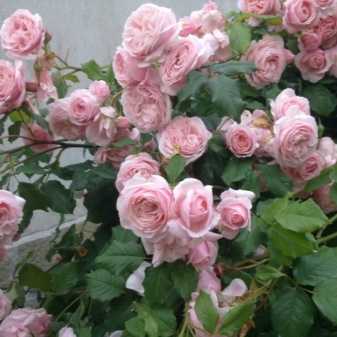
"Antik"
The climbing rose of the "Antik" variety is a multi-flowered climber. The flowers of the plant are colored pink with a white reverse, there are from 3 to 5 of them on the stem. The size of the flowers reaches 12 centimeters. The bush is large, its height is up to 3 meters, and its width is 200 centimeters. The recommended zones for growing a plant include the Moscow, Tver, Smolensk, Leningrad regions, as well as the Urals and the Middle Volga region. The variety is recommended for planting in April or late October.
The main feature of the rose is its large dense double flowers. They resemble ancient roses in shape. The color of the petals is rather unusual - white with a pink border. The shrub is characterized by vigor, good winter hardiness, resistance to fungi, precipitation and sunlight.
The disadvantage of the variety is the slow growth of the shrub. In a cold climate, the plant takes a long time to take effect, but its decorative qualities are at the highest level.
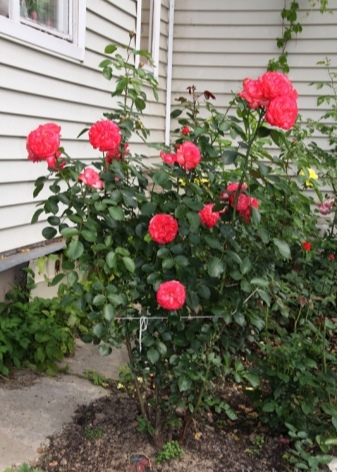

Coral Down
This rose has a deep pink color. The shrub leaves are dark, shiny, resistant to infection. Flower "Coral Down" is characterized by doubleness, spherical shape and a large number of petals. The shrub is dense and branched. The plant thrives in dry weather, as the softness of the foliage causes the petals to be severely damaged by excessive moisture.
7 flowers are concentrated in the brush, over time they can change color to a lighter pink. They reach a size of 10 centimeters, and also have a fragrant aroma. The foliage is dark green in color, it is shiny and leathery. The bush is characterized by spreading, in height it can reach up to 2 meters. The rose blooms profusely and for a long time, bears fruit well. The plant is very beautiful and winter-resistant.
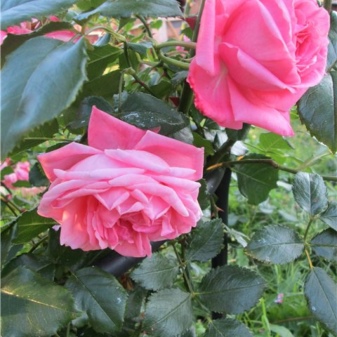
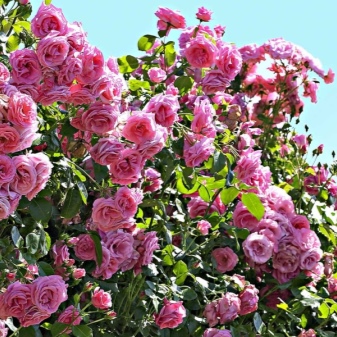
"Schneewalzer"
The Schneewalzer variety is a very beautiful plant that is characterized by abundant flowering and resistance to cold. The climbing rose is used for decorating and landscaping personal plots. The bush of this plant is abundantly covered with dark green foliage. Once the bud opens, you can see lemon or pale pink flowers. This type of rose is characterized by good frost resistance and disease resistance.
Acidified soils are suitable for cultivation. Planting should be carried out in the last days of April or May. In order for the rose to please its owners for a long time, it will be necessary to fertilize the rose in a timely manner, loosen the soil, weed out the weed, and cut the bush.
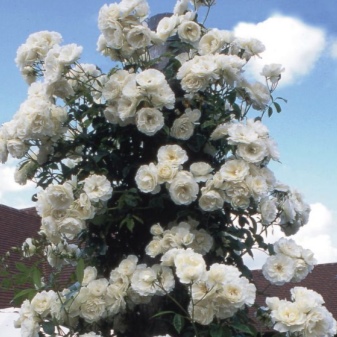
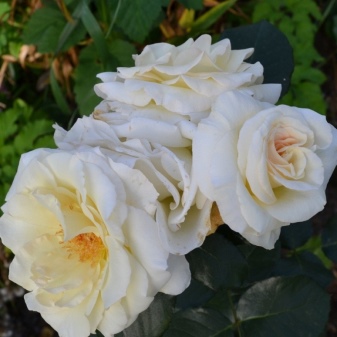
"Rosanna"
This variety is very popular with consumers. The rose is characterized by a long, powerful, branched stem, which is covered with glossy foliage with a dark green color. In the spring season, the bush is covered with many large, double, pink flowers, which are characterized by a coral shade and a pleasant fragrant aroma. This variety requires growing in a sunny and breathable area.
The flowering period of the plant lasts a long time, throughout the season. "Rosanna" is considered the leader among climbing roses in this indicator. In turn, it requires shelter for the winter season, as well as mulching.
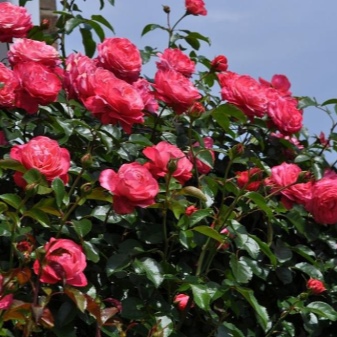
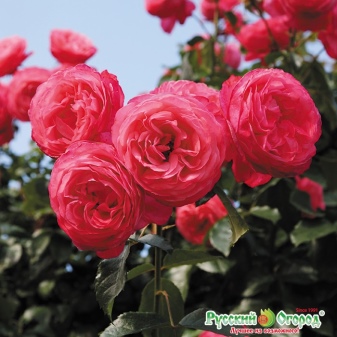
Excelsa
This rose has the appearance of a spreading liana, which has a rather high growth force. The shoots are drooping, flexible and long. In height, the plant can reach up to 4 meters, while having about two in diameter. The foliage of the shrub is colored dark green and is characterized by a special shine. The rose flowers are small in size but look quite elegant. Their shape is a rosette, which has a flattened base.
The diameter of the red flowers is 6 centimeters, they are characterized by thick doubleness and a subtle, subtle aroma. Each flower consists of 90 petals, which together give large inflorescences and dense brushes. The blooming period of "Excelsia" falls on the end of June, while a pleasant vanilla aroma is felt in the surrounding area. This variety is shade-tolerant and has good winter hardiness.
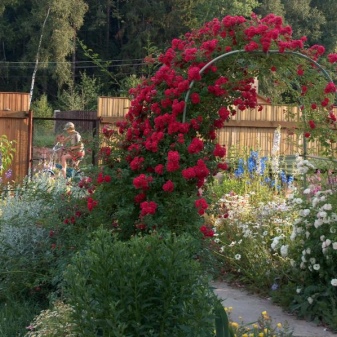
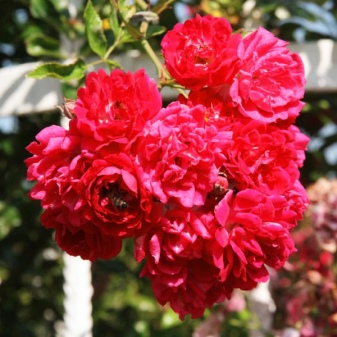
"Mont Blanc"
Rose variety "Mont Blanc" is characterized by a strong, large and vigorous bush, which reaches a height of about 3-4 meters. A strong and spreading shoot is covered with large, leathery leaves, which are painted with a dark green color. The flower is rounded, double, consisting of 70 petals. Its size reaches 12 cm, while the shape of the flower can be cup-shaped.
Blossoms "Mont Blanc" creamy color, over time the flowers become pink-creamy and even more charming. The flowering of the variety is quite long, it can last from early summer to late autumn. The main characteristics of the plant can be called good frost resistance, high decorative effect, versatility in use.
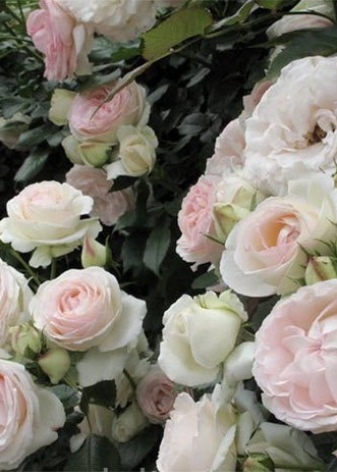
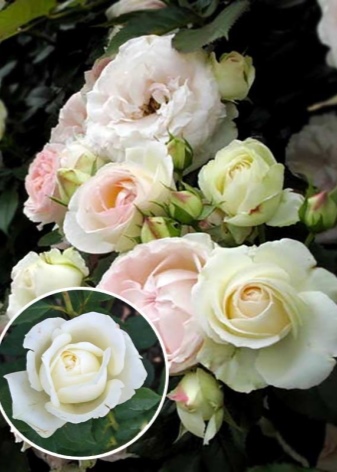
"Don Juan"
This variety is quite popular nowadays. The main features of the rose are winter hardiness, disease resistance. Don Juan is a shrub with large double red buds that smell good. The diameter of the flowers is at least 12 cm, while the height of the rose reaches 3.5 meters. The variety has found its application in landscaping walls, creating decorative arches. This rose requires good maintenance, regular feeding and tying.


Landing
To plant any of the climbing rose varieties on your site, it does not take much knowledge and effort. Such a procedure is quite within the power of even beginners. In order to plant shrubs, it is worth giving preference to an area well-lit by the sun, which is constantly ventilated.Most varieties of roses are good for light, but there are also varieties that prefer shade.
The best option for planting a rose would be the south or southwest side. It is not recommended to plant the plant on swampy soil that is subject to flooding or is characterized by high groundwater. It's no secret that it is best to plant a rose bush on loose, fertile soil that is moderately moist. In the case of high gravity of the soil, it should be lightened by adding sand, peat, humus with cow dung. In this case, the fertile layer should be at least 0.3 meters.
When choosing a site where it is planned to plant a fragrant plant, it is worth taking into account the fact that it may be necessary to lay the stems for the winter period of the year, but in such a way that they do not damage them against each other.
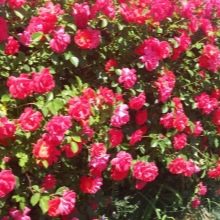
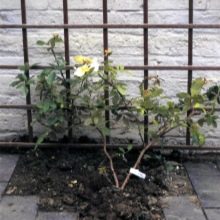
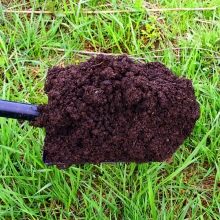
The next important step in the rose planting procedure is the selection of a quality seedling. A young individual should have several mature stems that have a woody structure and a green bark without damage. The seedling must have a strong root system with a large number of roots.
The planting procedure should be carried out in the autumn period - from September to October, or in early spring - from mid-April to mid-May. Planting depth should be 0.55-0.65 meters. In the case of an autumn planting, you will need to plant 2 cm deeper. But also do not forget that pre-winter planting of a seedling requires hilling with the help of earth mixed with sand. Thus, you can protect the young plant from drying out and freezing.
Before planting in the soil, the seedlings should be prepared. Young roses are soaked in water 24 hours before planting. And also with the help of a pruner, all present foliage, damaged shoots or unripe branches are removed. The roots need to be shortened by 0.3 meters. And it is also worth shortening the aerial part of the rose. Seedlings need disinfection, for this they are placed in a three percent solution of copper sulfate.

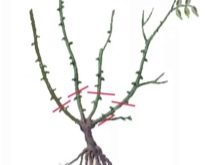

Direct planting of the plant should be started with the preparation of the hole. It should be dug out with dimensions of 0.5 by 0.5 meters. If you plan to plant more than one seedling, then it is worth observing the distance between them at least two meters. The placement of the roots in the hole should be free, without bending. The grafting site should be located at a point 10 centimeters from the hole level. The pit is filled with soil more than half, after which it is compacted. Thus, the soil will adhere well to the root system. The next step is to water the young plant.
After the liquid is thoroughly absorbed, the hole must be filled with soil to the top and the seedling 0.2 meters high is hilled. In the absence of rain, watering should be done every 5 days. After three days have passed from the moment of planting, it is worth removing the soil from the seedling. It is better to carry out this procedure in cloudy weather, when there are no sudden temperature changes.
Do not forget that the grafting point should remain at a depth of 0.1 meters, because new shoots will form from it.
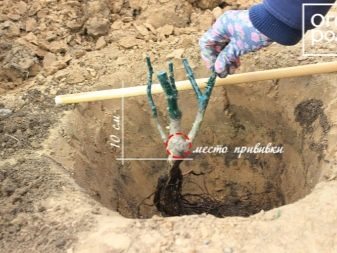
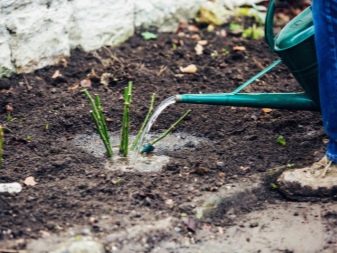
Transfer
It is worth replanting an adult rose only when it does not have enough space for normal growth and development, and also if the growing conditions, the soil, are not suitable for it. This procedure is carried out in early November. If you transplant the plant later, then it may not have time to take root before the onset of frost. And you can also carry out the process in the spring, but in this case, the gardener must have time before soil formation.
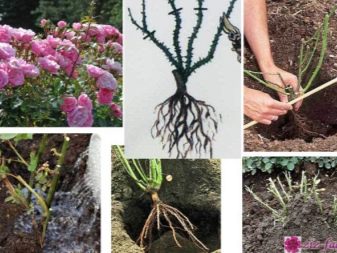
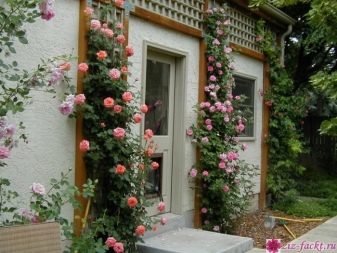
First of all, the rose is removed from the support, after which it is worth pinching the young shoots. Stems that are more than 24 months old should be removed and those that are too long should be shortened.The next step is to dig in the bushes in a circle, while you will need to indent from the center, which should be equal to at least two shovels. When working, it is worth remembering about the depth of the roots, they should be completely dug out without damaging them. It is worth shaking off the remnants of the earth from the roots, and with the help of a pruner, you need to remove shaggy root processes and eliminate the damaged ones.
The dug rose is placed in a prepared hole with a straightened root system. After that, the hole is covered with soil and compacted. Next, the plant needs to be watered. After several days from the moment of transplantation, it is worth adding soil to the rose in the missing volume and aligning the trunk circle. Also, do not forget about hilling the bush.
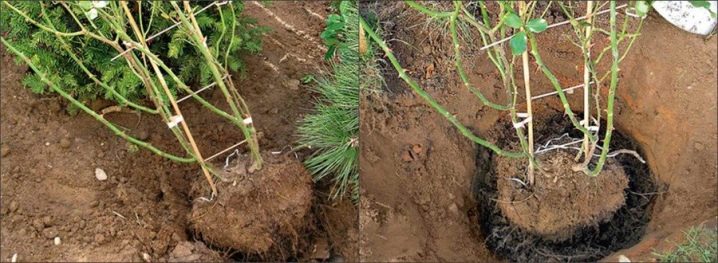
Care
In the process of caring for climbing roses, you will need to carry out regular watering, feed the plant, cut it off in time, loosen the soil, and also fight diseases and pests. For neat growth, the stems will need to be tied to a support. For the winter season, the plant should be covered.
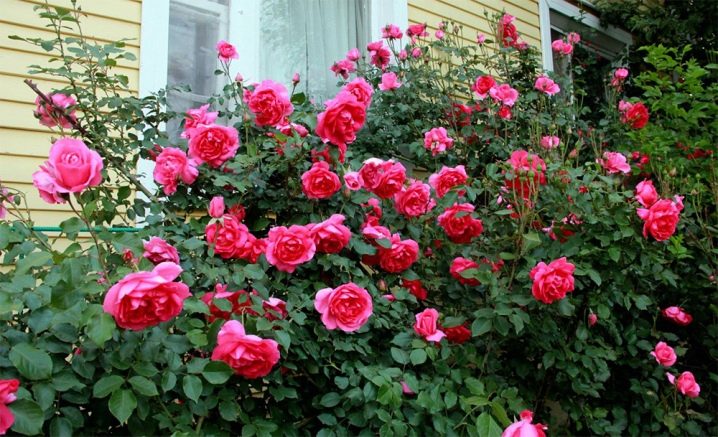
Watering
During the growing season, the rose needs a lot of moisture. That is why, after the buds are swollen and the pruning is done, the shrubs need to be watered every 10 days. During this procedure, the percolation of liquid should be carried out below the level of the roots. Each rose bush needs up to two buckets of water. After watering or rain, it is imperative to loosen the soil to a depth of 5 centimeters. Thanks to this procedure, more oxygen enters the soil.
With a lack of liquid in the soil, the volume of salts increases, and the growth of the plant also slows down. It is also worth remembering that an excessive amount of fluid contributes to the development of a fungal infection.
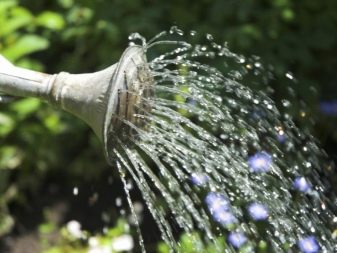
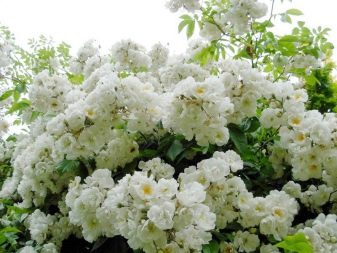
Top dressing
This type of rose, unlike all others, needs a large amount of fertilizer. It is required to feed the plants throughout the summer with a break of 10-20 days. Do not forget about the alternation of dressings. First, fertilize with nitrogenous fertilizers, and then with complex fertilizers. In this case, the substances can be both dry and dissolved.
At the beginning of the season, it is worth feeding the roses with liquid mineral fertilizers. After 10-20 days, it is recommended to feed the shrub with an organic fertilizer, which consists of a mixture of the following substances:
- mullein buckets;
- 5 liters of water;
- 3 kilograms of ash.
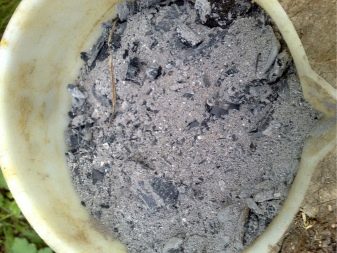
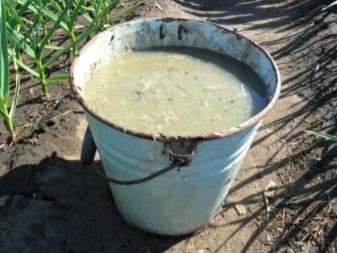
With this mixture, roses are watered at the root. Thanks to the above procedures, the plant blooms abundantly, and this also contributes to the bright coloration of the buds. Shrubs need such feeding until mid-summer, after which nitrogenous fertilizing is canceled and replaced with phosphorus or potash.
In order for the feeding process not to harm the roses, the dosage should be observed.

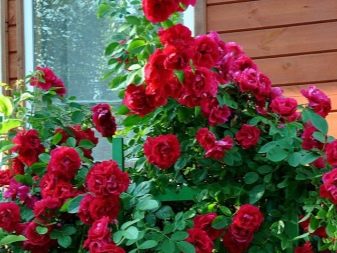
Pruning
You need to cut roses so that a beautiful crown is formed, and the bush is healthy, strong, and blooms for a long time. Young seedlings give new long stems, which must be laid in the soil and covered for the winter season. In springtime, the owner must cut the stems that are frozen and rotted, as well as the ends of the branches to the original bud. After that, the need for pruning arises depending on the period of the beginning of flowering of the rose.
In the case when a shrub blooms once, and flowers appear on last year's shoot, then they need to be completely cut off. To replace the pruned shoots, new young shoots grow, which will bloom next year. New shoots on re-flowering bushes appear within three years. Weakness of flowering is observed by the fifth year of the rose's life, so after 4 years the shoots should be cut off.

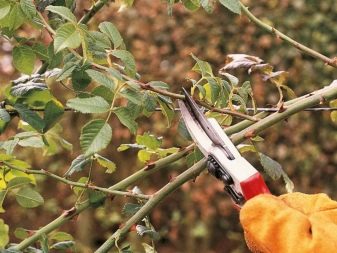
The process of pruning roses should be done in the spring. With this procedure, it is worth leaving only the optimal number of stems, which are characterized by youth, strength and stem length.Spring pruning should be done annually. And also the branches should be folded back and tied horizontally. This procedure stimulates the growth of a powerful young shoot and its vigorous flowering.
An important procedure is the removal of wilted flowers to the first leaf that looks outward. It is very important to remove the flowers after the first wave of flowering, as this will promote new shoot growth and flowering.
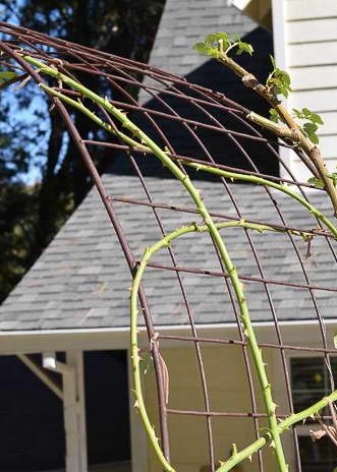
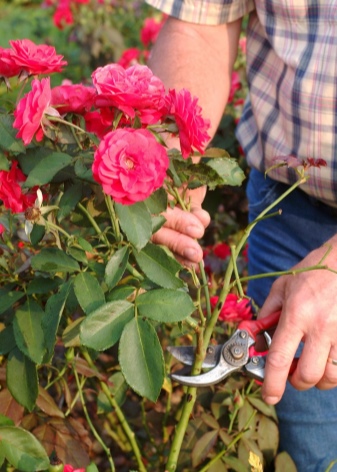
Winter care
To prepare the rose for the winter period, it is worth covering it. The procedure is carried out when the air temperature drops to 5 degrees below zero. It is not recommended to do this earlier, as the bush will not have time to harden or will start to rot. You need to cover the plant on a day when there is no rain or wind.
To begin with, the leaves are removed from the stems and the damaged parts of the rose are destroyed. Next, you need to tie the lashes with a rope and put them with extreme care on the littering surface. The plant must be fixed on the soil surface, sprinkled with soil or sand on top. Next, the rose should be covered with lutrasil, plastic wrap, roofing material or any other waterproof material.
Do not forget that there must be a layer of air between the rose and the surface.
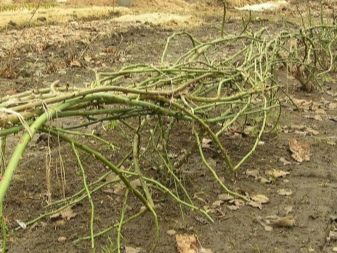
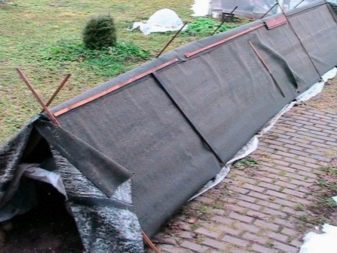
Diseases and pests
A climbing rose can be attacked by aphids and spider mites. With a small spread of aphids, it can be eliminated with folk remedies. Pests can be collected manually. To do this, with the help of fingers, a part of the plant is clamped and the aphid is removed. Gloves should be used during this procedure. This method is effective only in the initial stages of aphid infestation.
In a situation where aphids have plentifully attacked the rose, it is worth preparing a soapy solution. To do this, the soap is grated, poured into a bowl and filled with water. The substance should stand until the soap is completely dissolved. Next, it is worth filtering the substance and spraying it on the affected plant.
Provided that this method does not help, and the aphid continues to exist on the shrub, it is worth buying an insecticidal agent for grapes and roses. Treatment with a chemical preparation should be carried out on a calm, warm day.

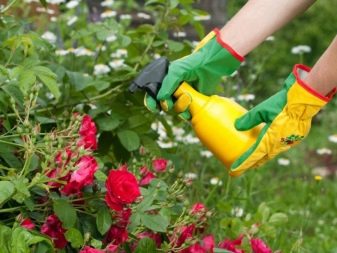
The attack of a rose by a spider mite occurs in dry hot weather, subject to rare watering. The pest settles on the seamy side of the leaves, while feeding on the juice of the rose and entangling it with its cobwebs. The leaves of the affected plant change color to green-silver. To eliminate the parasite, gardeners often use a tincture based on wormwood, makhorka, yarrow, and tobacco. After 3 days have passed from the moment of treatment with the substance, more than 80 percent of insects die, re-treatment can be carried out after 14 days.
The climbing rose can suffer from attacks of cicadas, thrips, rose sawflies, leaf rollers. But with timely and proper care of the shrub, the above parasites do not settle on it.
A preventive method of protecting climbing roses from pests is planting marigolds in the immediate vicinity. In autumn and spring, it is recommended to process fragrant arches with Bordeaux liquid.
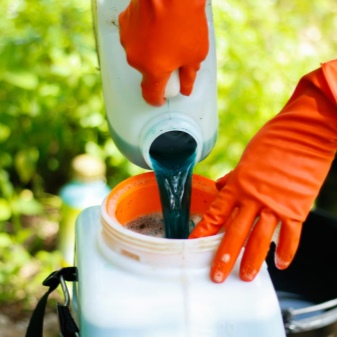
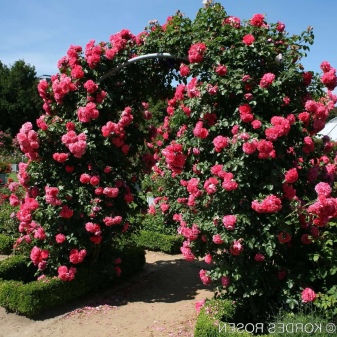
The most dangerous diseases for climbing roses are several ailments.
- Bacterial cancer. It manifests itself in the form of soft lumpy growths, which harden and darken over time. The result of untimely treatment of the disease is the complete drying of the bush. Unfortunately, bacterial cancer is an incurable disease, so when buying a seedling it is worthwhile to conduct a thorough examination. And also, as a preventive measure, it is recommended to disinfect the roots of the rose by placing them in a solution of copper sulfate. If growths are still observed on an adult shrub, then it is worth immediately cutting out the affected area, and also treating the cut with copper sulfate.
- Coniotirium is a fungal disease that is recognized as a burn or cancer. The disease is manifested by the appearance on the bark of spots of a brown-red color, which turn black over time. The affected stems must be cut off immediately to prevent the spread of the disease. As a prophylaxis for coniotirium in the fall, it is worth replacing nitrogen fertilizers with potash fertilizers. And also during thaws, shrubs need to be ventilated by raising their shelter.
- Powdery mildew. This type of disease is fixed when a white bloom appears on the plant, which turns brown over time. The cause of powdery mildew is considered to be high humidity, temperature drops, a large amount of nitrogen in the soil and improper watering. First of all, it is worth cutting off those parts of the rose that were attacked by the disease. After that, processing is carried out with copper and iron sulfate.
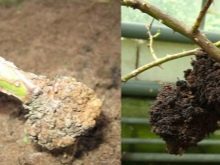
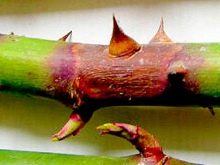
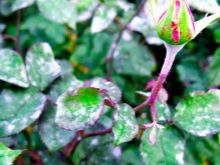
- Black spot. The appearance on the leaves of brownish-red spots with a yellow border indicates this disease. After a while, the spots can merge into one, thereby causing the leaflets to die off. As a preventive measure, in the autumn, the rose should be fed with phosphorus-potassium fertilizer. In addition, you will need to treat the plant and the soil around it with Bordeaux liquid and copper sulfate with a break of a week.
- Gray rot - this is the kind of rose disease that destroys all its parts. The plant loses its attractive appearance and is characterized by scarcity of flowering. If the disease strongly attacked the bush, then it must be dug up and destroyed. At the first signs of gray rot, the rose must be treated with a solution with the following components: 5 liters of water, 50 grams of Bordeaux liquid. To treat a rose, you need to carry out 4 treatments at intervals of a week.
Sometimes situations arise that a well-developed climbing rose bush refuses to bloom. The reason for this situation can be not only disease, but also poor quality of the seedling, unsuitable conditions for growth and development, freezing during severe frosts.
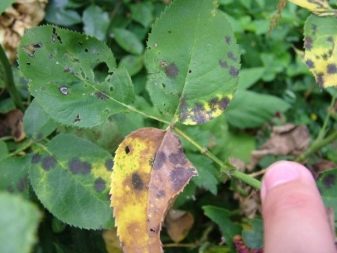
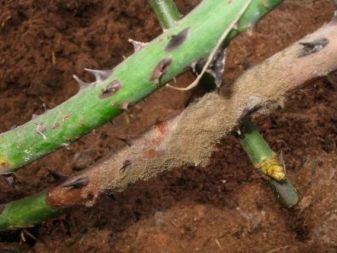
Reviews
Many people who cannot imagine their life without growing plants prefer climbing roses. With the help of this plant, you can decorate the territory and fill it with a fragrant unique aroma in the warm season. A well-groomed rose bush that wraps around an arch, a door, a decorative support, contributes to the moral enjoyment of the beauty of a flowering shrub. Such an environment not only pleases the eyes and smell, but also contributes to a good pastime in the fresh air.
Reviews of gardeners who planted a climbing rose on their site indicate that the plant is unpretentious in care, takes root well, rarely suffers from attacks of diseases and pests. Most people admire the beauty and aroma of climbing rose plantations. The main thing to remember is timely and proper care of flowering shrubs.
Only then can you get the decoration of the territory in the form of charming bright colors. When choosing a certain variety, it is also recommended to study in detail the peculiarities of its cultivation and follow the recommendations.
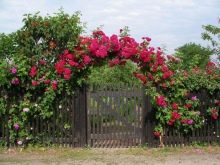


For the best varieties of climbing roses, see the next video.

































































































The comment was sent successfully.